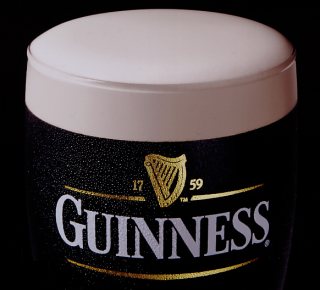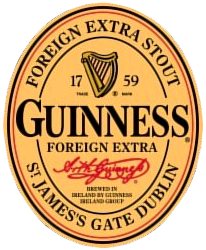 |

|
|

|
|
|
 |

home
about
features
A-Z
books

|

|

features
|

| |
Battle for the black stuff
by Willard Clarke, 11/06
The shock news that sales of Guinness have slumped by eight or nine per cent in the Irish Republic was one of those "end of civilisation" moments. If the Irish aren't drinking the black stuff, what hope is there for drinking kind?
The reasons for the decline in the fortunes of one of the world's iconic beers were many: changing lifestyles, with people drinking more at home and - according to some - forced to do so as a result of the smoking ban in Irish bars. Guinness has been hit especially hard in its home territory as most stout is drunk on draught. There is no canned Guinness (hurrah!) in Ireland and little in bottles.
|
|

|
But the most significant reason for the decline has been put down to the astonishing success of an Irish cider called Magners. You cannot have failed to see the ads, as the drink is also tearing up apple trees in Britain.
Two old friend lie behind Guinness and Magners - Grand Metropolitan and Bulmer's.
Older readers of a nervous disposition will recall the activities of Grand Met in Britain. It closed many breweries, including Wilson's in Manchester and Manns in London, and also produced in Watney's Red perhaps - and there are many contenders - the worst keg bitter in the known universe.
When it quit brewing in the 1990s it transformed itself into Diageo, a massive drinks conglomerate that merged with Guinness in 1997 and bought rival drinks group Seagram in 2003. At the time, there were murmurs that Diageo, with its awful track record in brewing, might not be the best custodian for Guinness as its real interests lie in such brands as Smirnoff vodka, Captain Morgan rum and Johnnie Walker whisky.
Now, with sales of Guinness falling in Ireland, there is speculation that Diageo could hive off stout production to concentrate on its spirits and wine business. I doubt it. Internationally, sales of Guinness are buoyant and Diageo has just broken into Russia, which after China is the fastest-growing beer market in the world.
Life-style aside, Diageo has only itself to blame for the fall in sales in Ireland. On my last visit to Dublin, after the obligatory tour round the magnificent brewery, I went to the Storehouse where the history of Guinness is brilliantly outlined. The visit is followed by a free half of the black stuff in a bar where, in the finest traditions of a Brit shouting at the natives, I complained that the BEER WAS TOO BLOODY COLD!
A polite Guinness representative patiently explained that most visitors to Ireland are not British but Americans and they demand cold beer. I pointed out the close proximity of the River Liffey for American tourists, but to no avail. A few years later the company launched Extra Cold Guinness, which failed in both Britain and Ireland but did great damage to the brand along the way.
As one Dublin barman said last month: "The company messed up the taste putting in the Extra Cold Guinness. Most bars, like ours, have had those taps taken out. It was tasteless."
Diageo will pay scant attention to my views, but I think they should address the bibulous version of the Irish problem by appealing to patriotism and highlighting the enormous contribution Guinness has made to the history and culture of Ireland. It should serve the beer at the right temperature - there's plenty of Bud around for visiting Americans - and should make available the sublime bottled Foreign Extra Stout (see below) for home consumption.

|
|
Where Magners is concerned, I am reminded of Winston Churchill's description of the Soviet Union: a riddle wrapped in a mystery inside an enigma. The company was founded in the 19th century by William Magner in Clonmel, County Tipperary. Along the way, it was taken over by Bulmer's but when the British cider giant was bought by Scottish & Newcastle, S&N; lost the rights to the brand in Ireland, which, to add to the confusion, is sold as Bulmer's in the republic.
Magners is now owned by a large drinks group called C&C;, formerly Cantell & Cochrane. Its massive promotion for the cider brand has reaped a profits whirlwind. Volumes rose by 250 per cent to August this year. Last year the figure was 200 per cent. Vast sums are being invested in the plant at Clonmel to keep pace with demand.
Magners' growth has led to an apple crisis. Fruit has been bought from Britain, France and the Netherlands to keep the factory in full production. As a welcome knock-on effect, the National Farmers Union in Britain reports that acres of countryside are being returned to apple production due to the resurgence of cider.
Magners makes much of the fact that its cider is matured in oak vats, but it doesn't say for how long. It adds that 17 different types of apple are used to make the drink, but is silent on the varieties used. Detect any Foxwhelp or Brown Snout on the flavour? I doubt it: more likely O'Cox's Pippins and Les Golden Delicieuses.
|
In the interests of research, I bought a litre bottle of Magners for tasting. I stuck it in the fridge for a while but drew the line at putting ice in the glass. When poured, it was pale brown with a pink tinge. The aroma had the faintest hint of apple, while it is horrifically sweet to taste.
Surfing the Internet for Magners, I came across several independent sites devoted to the cider. On one of them, a disappointed consumer described it as tasting like Irn bru. I would say it was more like Tizer.
But not so nice.
While shopping for Magners, I was delighted to find bottles of Guinness Foreign Extra Stout on the supermarket shelves. The beer is not easy to find and it was only made available in this country for the first time following the fuss made by CAMRA when Guinness axed the bottle-fermented Original.
FES, as it's known for short, is a truly historic beer and, like our old friend Worthington's White Shield, recalls the hey-day of brewing for export to the colonies of the British empire. FES is 7.5 per cent alcohol, it accounts for 40 per cent of all Guinness stout sold world-wide, and is the base for the even stronger versions of the beer brewed for the Belgian, African and Caribbean markets.
In the fashion of the 18th and 19th centuries, FES was a blend of two stouts: young and "stale". Stale was the result of being stored in wooden vats for many months where it picked up a lactic tang as a result of action by natural bacteria and wild yeasts. On a trip to the Dublin brewery, I was shown two large wooden vats in the cellars where, it was claimed, the stale version was matured.
Were those vats sufficient to account for the enormous volumes of FES? On a more recent visit, I noticed that the vats had become part of a floodlit display in the grounds and I doubt that the beer is still blended. But it remains a beauty.
It is brewed from pale malt, roasted barley and flaked barley. The hops are a blend of several varieties, including Galena, Nugget and Target, which create a pungent 60 units of bitterness. The beer has that slightly sour and musty aroma that brewers call "horse blanket". The aroma is complex, with bitter roasted grain, a woody and vinous note, and spicy hop resins. The palate is bitter from roast and hops, balanced by dark fruit, with a long, dry and bitter finish with hints of liquorice and dark mysterious fruits, including something akin to sour bananas.
|
|

|
If Diageo makes this classic stout available in Ireland I think the group could rapidly reverse the slump in sales.
|
|
home
about
features
A-Z
books
|

